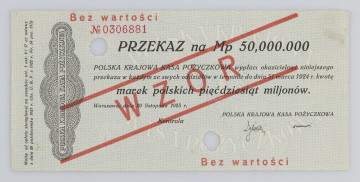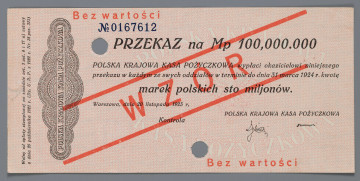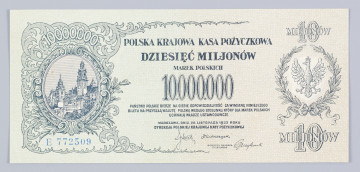
Cheque for 50,000,000 Polish marks - a template
1923
National Museum in Lublin
Part of the collection: Paper money during the Second Polish Republic
The Polish marks (mkp) of 28 August 1919 and 7 February 1920, with face values from 1/2 to 1000, are the best-known banknotes of the Second Republic (1918-1939). They were issued by the Polish National Loan Bank (PKKP), which was established by the German occupying authorities in 1916, and later adopted together with the mkp by the monetary system of the reborn Polish state.
Unlike the previous series from the first half of 1919, designed by Adam Półtawski (1881-1952), these banknotes were made at the Bolesław Wierzbicki Printing Works in Warsaw and, above all, at the Vienna State Printing House, where an unknown artist designed them in the Secession style. Their design, featuring Queen Jadwiga (1384-1399) and Tadeusz Kościuszko (1746-1817), is reminiscent of the Austro-Hungarian currency of the First World War. The money was to replace the easily counterfeited issues of the Półtawski design. Printing in a foreign factory was a result of growing demand for banknotes, which could not be satisfied by domestic plants.
The Vienna series denominations introduced into circulation from 5 December 1919 were intended to balance the state budget, in which expenditure was increasingly exceeding income. At the same time, offsetting the deficit with an increase in issuance stimulated inflation, which entailed a drop in state incomes, forcing the printing of new money. The rising price of the dollar the beginning at the start of 1919 amply illustrates the situation. At the end of June, it cost 17, three months later 35, and after the exchange rate was released at the end of 1919, it was already over 110 mkp. Before the series was introduced, there were almost 3 billion in circulation, a month later over 5 billion 300 million, and at the end of March 1920 already almost 10 billion 700 million mkp. A dollar then cost over 156 mkp. The good thing about inflation was that it boosted the economy and export competitiveness, reduced mkp debt and increased employment. Between the introduction of the banknotes in question (5 December 1919) and the inclusion of the next issue (25 January 1923), the nominal amount of the vmkp circulating increased more than a hundredfold.
In the first days of December 1919, the ‘Warsaw Courier’ (Kurier Warszawski) offered a 1000 mkp reward for indicating the location of a lost sable cloak with a white lining, and a fur-lined coat (bekiesz) for 550 mkp.
Tomasz Markiewicz
Author / creator
Dimensions
cały obiekt: height: 117 mm, width: 74 mm
Object type
paper money
Technique
Material
paper
Creation time / dating
Creation / finding place
Owner
The National Museum in Lublin
Identification number
Location / status

1923
National Museum in Lublin

1923
National Museum in Lublin

1923
National Museum in Lublin
DISCOVER this TOPIC
National Museum in Lublin
DISCOVER this PATH
Educational path